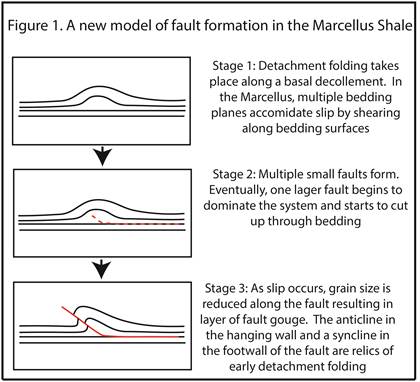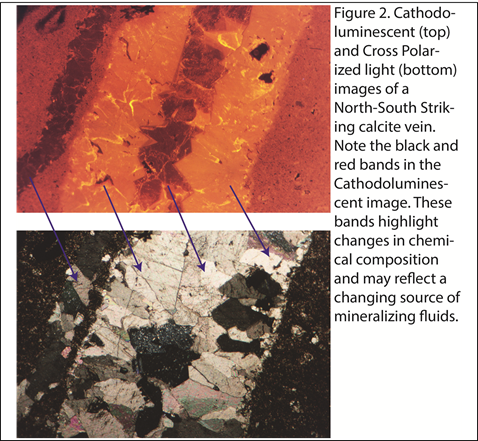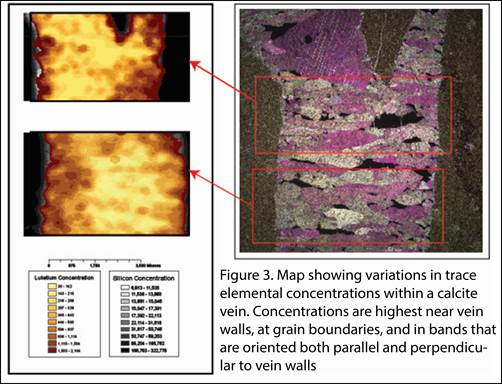Reports: ND851202-ND8: Fluid Flow Analysis in Fractured Rock using Structural Geometry and Geochemical Tracers (Noble Gas Isotopes and Trace Elements)
Gautam Mitra, PhD, University of Rochester
This research is aimed at understanding fluid flow through low permeability rock formations, and it specifically deals with how faults and fractures affect geologic fluid flow. Despite considerable research, our understanding of fluid flow in fractured rock is still lacking in two areas: (1) there is currently no reliable way to accurately predict the location or characteristics of natural fractures in the subsurface; and (2) it is unclear which geologic structures are most important for accommodating subsurface fluid flow. As such, it is difficult to predict the conduits that fluids will follow while migrating in the subsurface.
To address these questions, our research focuses on trying to understand the relationships between folds, faults, fractures, and past geologic fluid flow events. Additionally, it improves our ability to predict current subsurface natural fracture characteristics by determining how tectonic history, stratigraphy, present day depth, and large scale geologic structures control fracture formation, and it leverages multiple geochemical techniques to identify which fractures are most important for subsurface fluid flow. We have found an intimate relationship between fault zones, fracture development and fluid pumping, even in the earliest stages of fault zone development. Additionally, our data suggests that although tectonic history controls fracture orientation, stratigraphy determines the length and intensity of fracturing. This research has implications for hydrocarbon exploration in shales and mudstones and in utilization of such “tight” formations as seals for geologic carbon sequestration.
Research Focus & Methods
The three major topics we are pursuing are: (1) developing an understanding of how regional structures affect the fracture network present in the Appalachian Plateau; (2) evaluating how burial and tectonic history created and altered the fracture network; and (3) determining the relative importance of fractures and faults as conduits for subsurface fluid flow. Our research focuses on the carbonates and shales of the middle-Devonian Hamilton group, which outcrop across the Appalachian Plateau. These rocks are gently folded and faulted, and display a network of extension fractures and shear fractures everywhere across this region.
This year, we collected a final suite of samples of calcite veins from rock quarries, and drill core from wells through the Devonian section: 3 new cores in New York and 2 additional cores from Pennsylvania. In each core, we carefully recorded lithology and structural characteristics of fractures. Samples were analyzed in the laboratory using optical microscopy, cathodoluminescence (CL) microscopy, scanning electron microscopy (SEM), fluid inclusion analysis and geothermometry, and trace elemental mapping with cryogenic laser ablation ICP-MS.
This year, we compared fractures found in outcrop and core, examined how present day depth and maximum burial depth impact fracturing, and we developed regional models for fault and fracture development in the Appalachian basin.
Preliminary Results
The fracture network in the Appalachian basin is complex. We have observed at least 7 different sets of fractures (mineralized veins and barren joints) in outcrop and in core, and these features can be found throughout the Appalachian Plateau. There are several key relationships that can describe this fracture network: (1) not all fractures found in outcrop are present at depth, and unmineralized joints are very rarely observed in samples taken from depths greater than 1000’; (2) although the orientation of surficial joints is always the same around the Appalachian plateau, mineralized veins and faults show a rotation in fracture orientation that is consistent with rotation in Alleghanian folds; (3) stratigraphic thickness controls fracture length and density; and (4) large scale faults overprint this regional fracture trend to create local damage zones.
This detailed fracture work has allowed us to create more detailed models for fault growth in the Appalachian basin (Figure 1) and enrich our understanding of fracture systems in foreland basins.
Optical microscopy of veins shows euhedral calcite crystals and some pyrobitumen. Vein texture indicates growth from the walls of the vein towards the center, i.e. syntaxial crystal growth. Cathodoluminescence microscopy coupled with Cryogenic laser ablation ICP-MS suggest cross-fold veins formed from a different fluid source than veins that strike parallel to fold trends. The cross-fold veins luminesce more weakly than strike-parallel veins and show a different Ca-Mg ratio. This difference is likely due to differences in the temperature of migrating fluids.
There are also differences in the chemical composition within individual veins. Segments of veins luminesce brightly, while other segments remain very dark-indicating that these crystals might contain different elemental compositions (Figure 2). These changes in luminescence are not accompanied by an obvious optical change; grain boundaries do not mark changes in chemical composition. We have produced several microsampling elemental maps highlighting changes in chemical concentrations; variations in luminescence appear to be linked to changes in trace element concentration (Figure 3). While more data is forthcoming, these results suggest that veins may have complex growth histories that involve multiple mineralizing events. The data also suggest that “healed” veins may re-open and act as conduits for geologic fluids.
Impact and Future work
The ACS-PRF New Directions grant has allowed us to study some of these fundamental questions using new techniques and to integrate structural geology with geochemistry. One Masters student (completed) and one Ph.D. student (ongoing) have been partially supported on this grant; eight abstracts have been published. The experience gained by the PI in this project has helped him to start working on similar problems of fluid flow in the Sevier fold-thrust belt in Utah using a combination of structural and geochemical tools.
There are many unanswered questions and abundant room for improving our fundamental understanding of subsurface fluid flow processes. We will continue our examination of the fracture network in the Appalachian basin and use geochemical techniques to analyze the veins that fill these fractures. Now that we have characterized how fractures interact with large-scale structures, we will focus our work on the role of burial and exhumation history. By applying our toolbox of geochemical methods we will continue to study how the fracture fabric in the Appalachian plateau changes and determine if these changes altered the way in which fractures conducted fluids.














